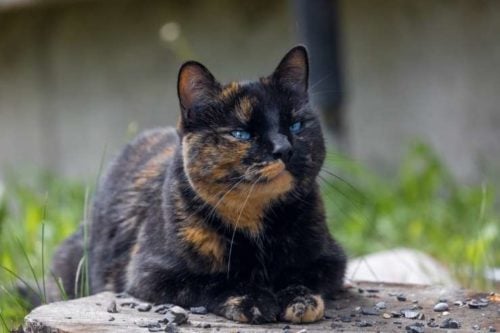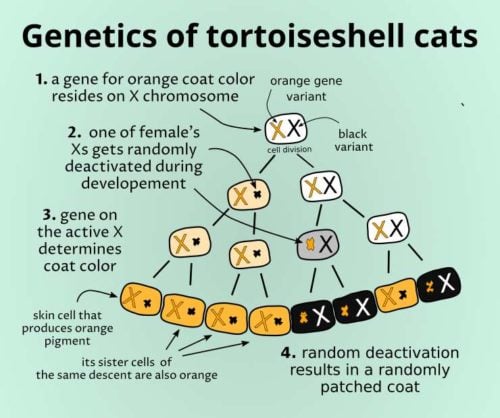Male tortoiseshell and calico cats are rare. They are extremely rare, at the same time, not everyone is aware of it. We have a female tortie cat, but because of her decent body size, many of our visitors often assume it’s a boy. One of our friends even has nicknamed her Mr. Tom. However, her name is Jersey, and she’s a girl, just as all tortoiseshell cats are female. Or are they?

Cat coat color is determined genetically, and there’s a reason why tortoiseshell and calico cats MUST be female. “Must” does not mean that they are. In rare cases, a genetic disorder can cause a male cat to inherit tortoiseshell coat color generally restricted to females. In fact, only one in 200 UK male cats is a tortie. We have no wonder why, even professionals, so often mistake them.
Why are only female cats normally tortoiseshell?
So, let’s delve deeper into why male tortoiseshell and calico cats are rare. To do that, we have to understand how normal tortoiseshell pattern develops. And yes, we must talk a bit about chromosomes and genes, since the coat color is a genetic trait.
Too long, didn’t read: Gene for orange coat resides on an X chromosome. It has two variants: orange and black. Female cats have two X chromosomes; male cats have one. Therefore, only female cats can possess both variants of the gene and have both colors in their coat. Males have only one X chromosome and can’t have black and orange color simultaneously in their fur.
All mammals have two sets of chromosomes. Humans have 23 pairs of chromosomes, cats have 19 pairs. In each pair, both chromosomes have the same genes, but possibly in different flavors. For example, there may be a gene for curly hair on one, and a gene for straight hair on the other of sister chromosomes.
X and Y chromosomes, however, are special in this regard. Males get one X and one Y chromosome, whereas females have got two Xs. This means that only females can carry two variants of any genes residing on an X chromosome. And so it happens to be the case with orange coat color of cats.
However, there is a twist.
In each of the female cells, only one of the two X chromosomes is active. Which of them stays active is randomly decided during embryonal development while the cells are still actively dividing.
A cat embryo starts to grow from a single cell in his mother’s uterine. The cell copies its whole DNA and divides. The process repeats many times. At one point, if a cell has two X chromosomes, one of them gets deactivated. After that point, the cell continues to divide, yet each of its daughter cells will have the same X chromosome active.
See a simplified picture below. You can see that, if a cell’s X becomes inactive earlier in the course of development, it will be surrounded by a larger clump of identical daughter cells around it. If the cell’s X get’s deactivated late in the development, a cluster of its daughter cells will be smaller.

The cat’s skin will eventually consist of patches of skin cells from different origins and with different variants of coat color gene active. Thus, the female cat’s coat will be patchy.
Since male cats have only one X chromosome, they can have the orange OR black version of the gene. Thus, their coat can’t form the tortoiseshell pattern, since it needs both colors.
How come there are male tortoiseshell cats?
But wait a minute. At the beginning of this article, we mentioned that 1 in 200 male cats in the UK are tortoiseshell. How is this possible? If a gene for orange and black coat color must be on two different X chromosomes, how can male cats have both colors?
The answer is simple; some male cats have two X chromosomes.
Copying of chromosomes is not as perfect as you might think. Things go awry often, and males with two X chromosomes are not rare. Typically cells divide like this: a cell duplicates all of its DNA and splits half, leaving one full set of chromosomes in both newly formed cells.
However, on many occasions, the chromosomes do not divide equally in half. For example, one cell could receive two X chromosomes and leave the other one with none.
In humans, a condition where a male has two X chromosomes is known as Klinefelter syndrome. It is a consequence of chromosomal disorder during the development of sperm or egg. We’re not going to dive into it. Yet, the interesting thing is that studying male tortoiseshell help researchers answer questions about this syndrome since its impact on the body and mechanisms of development are highly similar in both humans and cats. But back to coat color.
When a male cat has two X chromosomes in addition to its Y, it can potentially have both colors in its coat. The rest is similar to female cats. In some cells, the orange version of the coat gene will express, while the black version in others. The cat will have a patchy coat, characteristic to female tortoiseshell cats.
Note that a cat can also have a white color in his or her coat. A gene for white color is independent of orange and black, but, if it is present, the cat will be a calico instead of tortoiseshell.
Do tortoiseshell cats have health problems?
We said that male tortoiseshell cats are a result of a genetic disorder. So, is it bad?
Two X chromosomes in males not necessarily mean terrible things. They can be nasty, and it would be improper to say that Kleinfelter syndrome is less troublesome when compared to other syndromes of a similar mechanism, such as Down syndrome. But what about cats?
X chromosomes are not that large, and one of them gets deactivated during the development anyways. Things that are associated with XXY male cats (not necessarily tortoise) are smaller size, feminine look, reduced testicles, and infertility.
The thing is, if you plan to neuter your cat, potential infertility might not scare you. If you have an opportunity to adopt a male tortoiseshell or calico cat, don’t let potential health problems scare you.
If, on the other hand, someone asks you money for a rare male kitten, you should think twice. Not because the health will be an issue (it could be, though), but because this kind of business, wittingly breeding and raising kittens with genetic disorders, is dubious.
